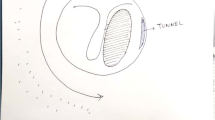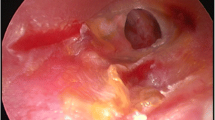Abstract
To compare the results of myringoplasty by using operating microscope (postaural) with that of myringoplasty by using endoscope (permeatal). Our study was conducted in Department of ENT of in Chirayu Medical College and Hospital. Total 60 patients of age group 18–60 were taken for study having chronic otitis media or trauma with central perforation. Patients were randomly selected microscopic or endoscopic myringoplasty. 30 patients for Microscopic Myringoplasty and 30 patients for endoscopic Myringoplasty were selected. Out of total 60 patients 35 were females and the 25 were males, 27 were in the age group 15–30 and 23 were in age group 31–45 and only 10 in the age group of 46–60. 18–30 age group cohort was predominant. The average time taken for endoscopic myringoplasty was 65.5 ± 3.45 min and for microscopic myringoplasty 85.7 ± 3.42 min. 26 were having Large central perforation (LCP), of which 13 underwent microscopic and 13 underwent endoscopic myringoplasty. The graft was taken up in situ in 22 patients while 4 patients had small residual central perforation. Out of these four residual perforations 3 were done by endoscopy and 1 by microscopy. 19 (of 60) were having Medium size central perforation (MCP), 10 were operated with endoscope and 9 with microscope. 15 (60) were having Small central perforation (SCP), 7 done with endoscope and 8 with microscope. In all patient graft take up was well. Large central perforation present in maximum patient and had least graft uptake as compared to MCP and SCP. Out of the 30 these endoscopic myringoplasty 27 patients had good graft uptake and 3 had small central residual perforation after 3 months. Out of the 30 microscopic myringoplasty 29 patients had good graft uptake and 1 patient had small central residual perforation after 3 months. In our study pre operative and post operative Air Bone Gaps (ABGs) were 22.05 ± 2.04 and 9.05 ± 1.36 db respectively in endoscopic myringoplasty and 21.81 ± 1.85 and 8.55 ± 1.44 db respectively in microscopic myringoplasty. Microscopic myringoplasty has greater success rate in larger perforations that is LCP and MCP and equal result in SCP. Advantage of microscope is depth perception and both hands are free for procedure which is limitation of endoscopic myringoplasty (need to use endoscope holder). Advantage of endoscopic permeatal myringoplasty is superior visualization, least tissue trauma and better cosmetic outcome, almost equal graft uptake and hearing outcome with less operative time. Endoscope system is portable, so convenient for surgeon where microscope is not available. Also endoscope is a less costly armamentarium. Our study shows better result in myringoplasty can be achieved if both methods of surgery are used in combination.
Similar content being viewed by others
References
Frootko NJ (1997) Reconstruction of the ear. In: Kerr AG, Booth JB, editors. Scott Brown’s Otolaryngology: Otology. 6th ed. Oxford: Butterworths-Heinnman 3: 1–25
Berthold E (1878) Ueber myringoplastik. Wier Med Bull 1:627
Wullstein H (1956) Theory and practice of tympanoplasty. Laryngoscope 66:1076–1093
Zollner F (1955) The principles of plastic surgery of the sound-conducting apparatus. J Laryngol Otol 69:637–652
Rafi T (2001) Tympanoplasty in children: A study of 30 cases. J Surg Pak 6:11–12
Manolidis S (2003) Closure of tympanic membrane perforations. In: Glasscock ME, Gulya AJ, editors. Glasscock-Shambaugh Surgery of the Ear. 5th ed. Ontario: BC Decker pp 400–19
Shea JJ Jr (1960) Vein graft closure of eardrum perforations. J Laryngol Otol 74:358–362
House WF (1960) Myringoplasty. AMA. Arch Otolaryngol 71:399–404
Karlan MS (1979) Gelatin film sandwich in tympanoplasty. Otolaryngol Head Neck Surg 1979(87):84–86
Schwaber MK (1986) Postauricular undersurface tympanic membrane grafting: Some modifications of the “swinging door” technique. Otolaryngol Head Neck Surg 95:182–187
Fernandes SV (2003) Composite chondroperichondrial clip tympanoplasty: the triple “C” technique. Otolaryngol Head Neck Surg 128:267–272
Juvekar MR, Jurekar RV (1999) The double breasting technique of tympanoplasty: a study of 200 cases. Indian J Otol 5:145–148
Goodman WS, Wallace IR (1980) Tympanoplasty—25 years later. J Otolaryngol 9:155–164
Hung T, Knight JR, Sankar V (2004) Anterosuperior anchoring myringoplasty technique for anterior and subtotal perforations. Clin Otolaryngol Allied Sci 29:210–214
Escudero LH, Castro AO, Drumond M, Porto SP, Bozinis DG, Penna AF et al (1979) Argon laser in human tympanoplasty. Arch Otolaryngol 105:252–253
Yadav SPS, Aggarwal N, Julaha M, Goel A (2009) Endoscope assisted myringoplasty Singapore medical journal 50(5):510
Patil RN (2003) Endoscopic tympanoplasty—definitely advantageous (preliminary reports). Asian J Ear Nose Throat 25:9–13
Khan I, Jan AM, Shahzad F (2002) Middle-ear reconstruction: a review of 150 cases. J Laryngol Otol 116:435–439
Patel Jaimin, Ayer R G, Gajjar y., Gupta R, Raval J, Suthar P P, Endoscopic tympanoplasty vs Microscopic tympanoplasty in tubotympnic CSOM, a comparative study of 44 cases
Ahmad A, Hashmi F, Hashan SA (2016) Prospective study comparing the results of endoscope assisted versus microscope assisted myringoplasty. Glob J Oto 1(4):1–6
Kumar S, Kumar A (2017) Endoscopic type I tympanoplasty in medium sized tympanic membrane perforation: IOSR Journal of Dental and Medical Sciences (IOSR-JDMS) e-ISSN: 2279-0853, p-ISSN: 2279-0861. 16(2) Ver. III, pp 58–6
Rıza D, Erkan K, Fatih KS, Mehmet A, Deniz H, Nuray BM, Cemal C (2014) Endoscopic versus microscopic approach to type 1 tympanoplasty in children. Int J Pediatr Otorhinolaryngol 78:1084–1089
Kojima H, Komori M, Chikazawa S, Yaguchi Y, Yamamoto K, Chujo K, Moriyama M (2014) Comparison between endoscopic and microscopic stapes surgery. Laryngoscope 124:266
Author information
Authors and Affiliations
Corresponding author
Ethics declarations
Conflict of interest
All authors declare that they have no conflict of interest
Ethical consideration
Both microscopic and endoscopic myringoplasty are established method of treatment. There is no ethical conflict.
Electronic supplementary material
Below is the link to the electronic supplementary material.
Rights and permissions
About this article
Cite this article
Maran, R.K., Jain, A.K., Haripriya, G.R. et al. Microscopic Versus Endoscopic Myringoplasty: A comparative study. Indian J Otolaryngol Head Neck Surg 71 (Suppl 2), 1287–1291 (2019). https://doi.org/10.1007/s12070-018-1341-4
Received:
Accepted:
Published:
Issue Date:
DOI: https://doi.org/10.1007/s12070-018-1341-4




